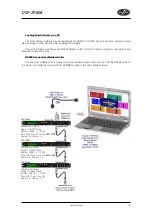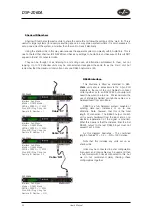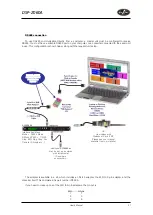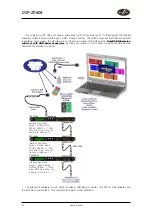
33
<- Creating a Flat-topped EQ Response
To create a flat-topped EQ filter response such as that shown to the left, use two EQ bands, BOTH
configured as low shelves. For an overall BOOST, set the Lower frequency filter to BOOST the desired
amount, and the Upper frequency filter to CUT by the same amount.
This example shows one filter at 100Hz and the other at 2kHz, with the 100Hz filter at –10dB, and the
2kHz filter at +10dB. Varying the 'Q' affects the slope of the response – values above 0.75 will cause
overshoot as shown.
Assymetrical responses may be achieved by adjusting the 'Q' of each filter independently.
<- Shelving EQ (High Shelf shown)
InA Input A HSF:1-<::
1k00Hz Q = 3.0 0.0dB
Remember – to change filter types, press BYPASS to bypass the filter, and then use ENTER to select the
filter type.
The shelving EQ has adjustable frequency, 'Q' (or Bandwidth) and Gain controls. These affect a range of
frequencies from the turnover freqency as shown in the graph. For a high shelf, frequencies above the
turnover frequency will be affected. For a low shelf, frequencies below the turnover frequency will be affected.
Remember that 'Q' is 1/Bandwidth, so the higher the 'Q', the lower the Bandwidth, and the smaller the
range of frequencies affected.
DSP-2060A
User’s Manual
Summary of Contents for DSP-2060A
Page 2: ...DSP 2060A ...
Page 6: ...DSP 2060A User s Manual ...
Page 8: ...DSP 2060A User s Manual ...
Page 43: ......




















